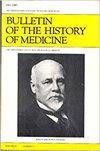《1720年的瘟疫恐慌:18世纪大西洋世界的灾难与外交》,Cindy Ermus著(评论)
IF 0.8
2区 哲学
Q4 HEALTH CARE SCIENCES & SERVICES
引用次数: 1
摘要
减轻了蠕虫,坐在烤洋葱上治好了痔疮。拉奈拉还与外国人交换了药物治疗方法,并将其送往哈特利卜,通过她与肯特伯爵夫人伊丽莎白·格雷的友谊,帮助确定了广泛流传的常见药物的权威版本。她还编写了自己的食谱,看起来她有基于复杂化学程序的治疗方法——边缘和蒸馏器、蒸馏和钙化、化合物和矿物质——这些都没有送到哈特利卜。她将更复杂的补救措施保密,因为广泛传播这些补救措施可能弊大于利。拉奈拉给家人和朋友送去了药物,例如,哈特肖恩唤醒了克拉伦登夫人,并给威廉·佩恩生病的儿子送去了一剂药水。她总是急切地想知道补救措施是否有效。她与哥哥在许多医疗问题上合作,分享诊断信息,就治疗方法达成一致,并借用原料。两人都对医生不愿尝试新疗法持批评态度。拉奈拉是经验的坚定信徒,他对只靠书本学习和毫无帮助的无能医生尤其愤怒。这本传记是科学文化史上日益增长的趋势的一部分,强调个人身份和生活史的作用。拉奈拉对神学和政治的兴趣,以及她对化学和医学的实践交织在一起。按时间顺序交织的方法,而不是对材料进行更专题的分析,确实阻碍了对她的实际贡献的辨别。DiMeo做了一项令人钦佩的工作,揭示了17世纪最受钦佩的女性之一的智力追求。即便如此,正如作者所承认的那样,我们经常不确定她的实际角色:博伊尔的医学作品“可能包含了拉奈拉夫人的更多贡献,这是我们无法肯定的”(第184页)。本文章由计算机程序翻译,如有差异,请以英文原文为准。
The Great Plague Scare of 1720: Disaster and Diplomacy in the Eighteenth-Century Atlantic World by Cindy Ermus (review)
alleviated worms, sitting on a roasted onion healed hemorrhoids. Ranelagh also exchanged medicinal treatments with foreigners and sent these to Hartlib and, through her friendship with Elizabeth Grey, Countess of Kent, helped identify the authoritative version of common remedies in wide circulation. She also compiled her own recipe books, and it looks like she had remedies based on intricate chemical procedures—limbecks and stills, distillation and calcification, chemical compounds and minerals—which were not sent to Hartlib. She kept the more complicated remedies private because widespread dissemination of them could do harm than good. Ranelagh sent medication to family and friends, for example, hartshorn to rouse Lady Clarendon, and a potion to treat William Penn’s sick son. She was always eager to hear if a remedy worked. She collaborated with her brother on many medical issues, sharing diagnostic information, agreeing on remedies for treatment, and borrowing ingredients. Both were critical of the physicians’ unwillingness to try new remedies. Ranelagh, a firm believer in experience, was particularly incensed by book learning only and by ineffectual doctors who did nothing to help. This biography is part of a growing trend in the cultural history of science to emphasize the role of personal identities and life histories. Ranelagh’s interest in theology and politics alongside her practice of chemistry and medicine are woven together. The chronological, interwoven approach rather than a more thematic analysis of the material does inhibit discerning her actual contribution. DiMeo does an admirable job of uncovering the intellectual pursuits of one of the most admired women of the seventeenth century. Even so, we are often not sure of her actual role, as the author concedes: Boyle’s medical works “probably incorporate more contributions from Lady Ranelagh than we will ever be able to confirm with certainty” (p. 184).
求助全文
通过发布文献求助,成功后即可免费获取论文全文。
去求助
来源期刊

Bulletin of the History of Medicine
医学-科学史与科学哲学
CiteScore
0.90
自引率
0.00%
发文量
28
审稿时长
>12 weeks
期刊介绍:
A leading journal in its field for more than three quarters of a century, the Bulletin spans the social, cultural, and scientific aspects of the history of medicine worldwide. Every issue includes reviews of recent books on medical history. Recurring sections include Digital Humanities & Public History and Pedagogy. Bulletin of the History of Medicine is the official publication of the American Association for the History of Medicine (AAHM) and the Johns Hopkins Institute of the History of Medicine.
 求助内容:
求助内容: 应助结果提醒方式:
应助结果提醒方式:


